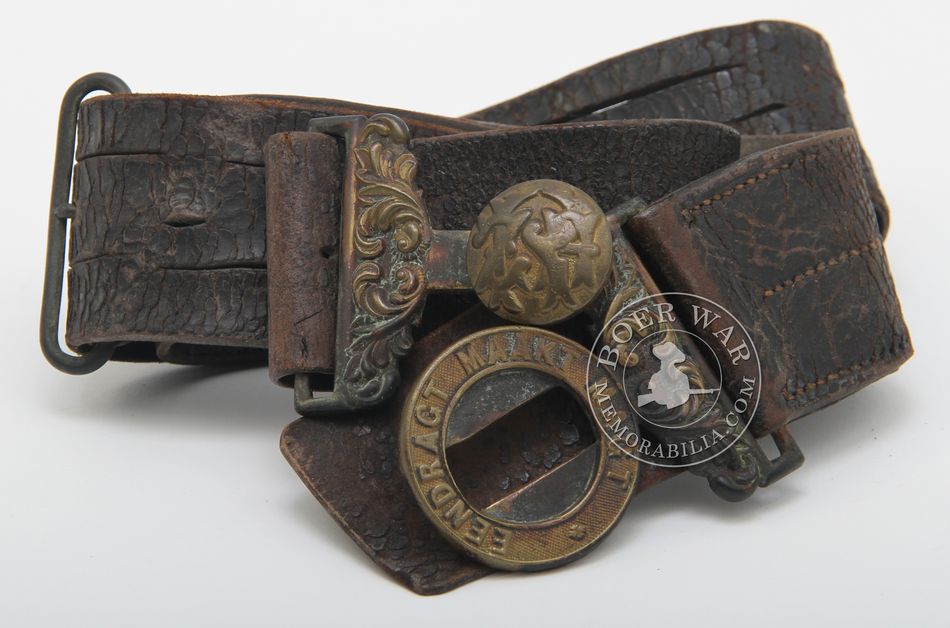|
View the embedded image gallery online at:
https://boerwarmemorabilia.com/index.php/memorabilia/military-insignia/item/115-zar-belt-2-boer-forces#sigProId2bc6c33f8e |
Item Ref# KS6138
ZAR Belt 2- Boer Forces
Brief description: Another scarce and original leather belt and brass buckle for the Zuid Afrikaansche Republiek’s uniformed police – Zuid Afrikaansche Ruitende Politie (ZARP). Material: Leather and brass Manufacturer: Unknown Artist: Unknown Circa: 1880’s Dimensions: tbc Weight: tbc Inscription: “Eendragt Maakt Magt” “ZAR" |

The Boers Big Maxim : Pom-pom
The Pom-pom was simply a large copy of Maxim’s gun firing a larger calibre projectile at a reduced rate of about 300 rounds per minute. It operated similar to the rifle calibre gun and also had a water jacket surrounding the barrel. Although originally designed for static mounts on ships and at naval installations, the Boer guns were supplied mounted on a “heavy” field carriage, later classified as: “Carriage, Field, 1-Pounder, QF (Mark I)”. Most Boer guns were also fitted with a shield, which proved extremely helpful against infantry and machine gun fire. Experience in the African veldt resulted in the 1897 order including a request for a modified axle for the gun carriage and only a single drawing pole instead of the usual tandem shafts on the limber. Harnesses to accommodate six horses were also ordered.
The most common ammunition used on land was black powder filled cast iron shells fitted with nose percussion fuses and fixed in brass cartridge cases. Looped cloth belts each containing 25 or 50 rounds was used to feed the gun, while the limber could carry twelve of the 25 round belts. Unknown to most the original steel armour piercing rounds, developed for the gun’s intended naval use were also supplied to the Boers and were probably used inland against armoured trains.
To propel its 1-pr shells, smokeless powder was used which, combined with the fact that it did not throw up a cloud of dust when fired, made the gun almost invisible to its enemies. The smoke from the bursting black powder projectiles on the other hand enabled gunners to determine range and guide their shots. Typically the maximum range was about 3000 yards, although hits up to 5500 yards were recorded under certain circumstances.
War Service
Before the war two Pom-poms were detached to each of the 2nd and 3rd Mounted (75mm Krupp QF) Batteries, while a further six guns formed the 4th Mounted or “Maxim” Battery. One or two Pom-poms were also posted in each of the four forts around Pretoria and possibly also at Johannesburg for close quarter defence. During the war they were however, like most Boer artillery pieces, not used in these battery formations but rather deployed individually, usually accompanying a commando. Some Transvaal guns also saw service with Free State commandoes, but it is believed that they stayed under control of their Transvaal crews.
The gun fitted in well with Boer concealed ambush tactics and was often camouflaged by covering the shield with canvas. The gun’s light weight and agility also made it popular during the later guerrilla phase. Its fire was especially effective against machine guns and mounted troops, with both men and horses being demoralised and confused. The aggravating bark, coupled with the fact that one burst meant more were on the way was trying on the nerves. Although the moral effect was considerable, the material effect generally was small, which forced gunners to shift the point of impact before the recipients could get used to the explosions. If used correctly the gun achieved good results and great trust was placed in its effectiveness. Even Pres. Kruger once declared to Combat Genl. Van Rensburg that he should have more faith in the Lord; and the big Maxim that can “…shoot an armoured train to pieces.”
Ironically the British Army, against the advice of MNG&ACL’s military advisor, at first ignored the Pom-pom as a land weapon. Sir Hiram himself described the situation rather strikingly: “the Boers were of a different opinion. They purchased a considerable number of them and, when war broke out, it was found that three or four Boers, concealed in the bush and using smokeless powder, were able to put a whole battery of English field guns out of action in about ten minutes. As a rule they succeeded in killing all the men and horses before the English could find the range or ascertain from what quarter the explosive projectiles were coming. It is impossible to take sight at a sound.” Although slightly exaggerated, this statement explains why the Pom-pom arguably became the most feared weapon of the war. Troops staring down its barrel “dreaded it more than any other gun”.
After its effectiveness was appreciated, the British Army reversed their previous rejection of the weapon. One day after Boer Pom-poms contributed to his disaster at Colenso, General Buller wrote: “I should like some Maxim-Nordenfelt 1 pr guns, if you can get them, to accompany mounted troops: they are wonderful weapons….” Fifty were ordered, of which 49 (some say 57) were shipped to South Africa. Of these seven were later captured by the Boers.
| Scripture |
|
But Jesus looked at them and said, “With man this is impossible, but with God all things are possible. Matthew 19:26 |

